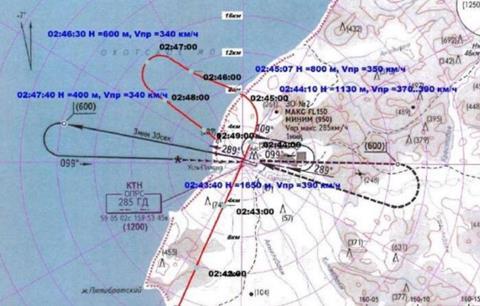Russian investigators have been unable to determine why the crew of an Antonov An-26 did not receive a ground-proximity warning before the twin-engined aircraft collided with a cliff while descending over water on approach to Palana airport.
But the Interstate Aviation Committee says that, despite unsuitable weather conditions, the crew attempted to conduct a visual circle-to-land approach.
Arriving from Petropavlovsk-Kamchatsky on 6 July 2021, the Kamchatka Aviation Enterprise aircraft followed an approach course which deviated significantly from the established procedure. It then dropped below the minimum descent height without the crew’s having stable visual contact with ground references.
Under the instrument procedure the aircraft should have entered a holding area near the airport, to reduce height, then followed a heading of 289° out to sea while descending to 600m. It should then have conducted a left turn to 099° to fly inbound to runway 11, with a minimum descent altitude of 450m.

But the inquiry says the An-26 – following a course from the south, parallel to the coastline – did not enter the hold, instead continuing to fly north for 4km. At an altitude of 1,350m the crew disengaged the autopilot and began a left turn to a heading of around 290-300°.
With no access to cockpit-voice recordings, the inquiry says it has been unable to determine “unambiguously” how the crew reached its decision to deviate from the approach procedure.
Palana airport had no primary or secondary radar installed at the time of the accident.
The aircraft, flying over the sea, then carried out a left turn while descending – against the procedure which required it to maintain 600m – and eventually rolled out on a heading of 135-140° at an altitude of less than 300m.

“Neither the crew nor the controller took any action to abort the approach,” says the inquiry, which adds that analysis of weather conditions suggests the crew had no visual contact with ground references as the An-26 approached the coastal cliffs.
Although the aircraft had entered a right bank of up to 6° about 3s before impact, the flight-data recorder showed no evidence of an instinctive pull on the control yoke characteristic of sudden obstacle detection.
None of the 22 passengers and six crew members survived the crash.
Even though the conditions for triggering a ground-proximity warning were met, says the inquiry, none was generated. Investigators could not reach a conclusion as to the reason, but list several possibilities: faulty equipment, non-activation by the crew, or errors in calculated aircraft position owing to insufficient numbers of navigation satellites.
The inquiry also points out that the ill-fated flight was the An-26’s first after its vertical speed indicators were replaced, and the crew’s situational awareness could have been affected.
Although the crew controlled the aircraft’s descent, and windshear was not a contributor, an increase in altitude was recorded after it fell below minimum descent altitude.
This was not the result of crew input, nor did the aircraft actually gain height, leading investigators to suggest the presence of localised airflow and air pressure fluctuations, resulting in overestimated barometric altitude readings, in the vicinity of the steep coastline.


























